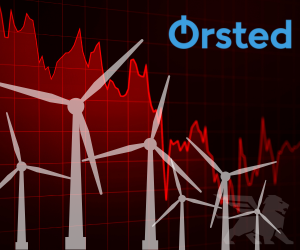ØRSTED SHARE SLUMP: WHAT HAPPENED IN 2025?
Ørsted A/S (ORSTED.CO), Denmark’s offshore wind powerhouse and a key player in Europe’s renewable ambitions, has endured a brutal 2025. Trading around 117 DKK as of 9 November, the stock has plunged 64% year-to-date and sits more than 80% below its 2021 peak. The collapse stems from the Trump administration’s clampdown on offshore wind in the U.S., where Ørsted had heavy exposure. Cancelled projects, regulatory delays, and write-downs have wiped billions off its books. To stabilise its finances, Ørsted raised 59.5 billion DKK (approx. €7.9 billion) in a deeply dilutive share issue and announced 2,000 job cuts. While the sale of half of its Hornsea 3 project brought in €5.5 billion, the company’s valuation remains stretched. For Ireland – which is ramping up its own offshore wind sector – Ørsted’s troubles are a cautionary tale about policy risk, financing strain, and the fragility of global green energy markets.

Why Ørsted’s shares collapsed
Ørsted, long viewed as Europe’s model for renewable transition, has seen its share price crumble through 2025. The primary trigger was political: U.S. policy reversals under Trump’s administration have targeted offshore wind developments, halting projects and freezing billions in investment. As Ørsted relied heavily on its American pipeline for growth, the reversal dealt a massive blow to future revenue streams.
Operationally, the company struggled as well. Third-quarter results showed weak wind output and a net loss, signalling operational turbulence even within its European portfolio. While management insisted that the balance sheet was “derisked” through asset sales and new capital, investors were unconvinced. A modest post-earnings rally of around 2% quickly faded.
Dilution and financial strain
In October 2025, Ørsted carried out a massive rights issue, raising 59.56 billion DKK (around €7.9 billion). While the move strengthened liquidity, it severely diluted existing shareholders’ stakes, dragging the price further down. The company also recorded billions in impairments from suspended U.S. projects – the kind of blow that shakes investor faith even in ESG stalwarts.
64% share price fall in 2025
Over 80% drop from 2021 highs
€7.9 billion raised via dilution-heavy rights issue
Project cancellations and write-downs in the U.S.
Investor confidence sharply reduced
For Ireland’s renewable industry, Ørsted’s fall highlights how quickly policy shocks abroad can unsettle even the best-run clean energy firms – a timely reminder as the country builds its own offshore infrastructure.
Ørsted’s recovery plan
Despite the rout, Ørsted has been proactive in shoring up its finances and focus. The company sold a 50% stake in its flagship Hornsea 3 offshore wind project in the UK to Apollo-managed funds for roughly €5.5 billion. This sale brought much-needed cash and signalled that investors still see value in Ørsted’s European assets.
The group also announced 2,000 job cuts worldwide, part of a restructuring aimed at reducing costs and improving efficiency. These changes, while painful, reflect a wider effort to reset the company’s strategy away from volatile markets and toward more stable European growth zones.
Refocusing on Europe
Ørsted is reaffirming its long-term vision: over 95% renewable energy generation by the end of 2025 and net-zero emissions by 2040. With U.S. headwinds persisting, its new focus lies squarely in Europe — particularly the North Sea, where regulatory conditions are more predictable. For Ireland, this may open doors for collaboration in offshore expertise, supply chain partnerships, and shared infrastructure development.
Hornsea 3 sale brought in €5.5 billion
2,000 job cuts to lower operating costs
Strategic pivot from U.S. to EU projects
Net-zero target remains for 2040
Potential collaboration opportunities with Ireland
With Europe’s offshore wind buildout accelerating, Ørsted’s ability to stabilise could directly influence Ireland’s own ambitions to become a green energy exporter in the coming decade.
Analysts’ outlook and Irish implications
Analysts remain cautious on Ørsted’s short-term prospects. At roughly 117 DKK per share, the stock trades about 66% above its estimated fair value of 70.76 DKK, suggesting more downside risk unless performance rebounds. Technical indicators still point to “sell,” reflecting continuing uncertainty.
On a brighter note, the company’s European assets – particularly Hornsea 3 and its upcoming North Sea ventures – could drive a turnaround if executed efficiently. Irish policymakers and industry leaders are watching closely, as Ørsted’s progress will likely influence confidence and capital flows in the wider European offshore market.
Lessons for Ireland’s green sector
Ørsted’s troubles offer key takeaways for Ireland: the importance of policy certainty, strong financing structures, and diversification of project risk. As Ireland advances its own Climate Action Plan and offshore tenders, ensuring stability and investor clarity will be vital to avoiding similar pitfalls. Ørsted’s experience shows that even market leaders are vulnerable to shifting political tides.
Stock trades 66% above fair value
Short-term indicators remain negative
European projects may offer recovery path
Ireland’s offshore push can learn from Ørsted
Policy consistency is key to investor confidence
In summary, Ørsted’s fall is more than a Danish story — it’s a signal for Ireland and Europe’s clean energy future: ambition alone isn’t enough without policy alignment, financing resilience, and steady execution.









